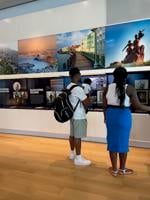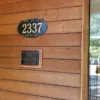Sixty members of the White family, spanning four generations, met for their 48th annual family reunion June 22 with a mission.
Gathered within the Center for Family History at the International African American Museum, staff worked with family members to weave genealogical threads and facts to paint a picture of the lives of their ancestors Anderson White and his wife Tyrah Cuthbert-White.
For cousins Reginald and Patricia White, these would be their third-great grandparents. Reginald White has long sought answers, having heard stories passed on from older generations about the couple who lived during the Civil War. Because of alias names and spelling variations in paperwork, finding a paper trail was difficult — but not impossible.
Using Census documents and a 300-page military record, the family has been able to confirm family fables and pull new threads to add to the narrative they pass down.
While much is still unknown about Anderson White’s life before joining the military and if he was free or enslaved, this much is clear: he served in the 21st Colored Infantry Company K, mustering at Fort Hilton Head. He joined just after the 1864 battle of Honey Hill, though he is memorialized with a misspelled name on the monument in Washington, D.C.
The IAAM turned one year old on June 27, and the White family are some of the thousands of visitors to use the museum’s resources to research their family roots. As museum administrators enter year two, they’re looking to expand their impact outside of the museum’s walls.

Jamaal Jakes (from left), Ashton Stapleton, Ariel Jakes and Jamaal James Jr. research history during the White-Cuthbert Family reunion at the International African American Museum’s Center for Family History on June 22.
“We saw this as an opportunity to draw on the museum’s resources to help us better understand our family legacy,” Patricia White said. “The research has validated some of what we knew by acknowledging the truth in stories that have been passed down and by adding more to the story.”
IAAM turns one
More than 187,600 people have visited the museum since its launch last year on June 27. Roughly 159,500 of them were ticketholders, while the other 28,000 were visitors that attended non-ticketed programs. IAAM sold out tickets in advance leading up to and months following the launch. Opening week attracted more than 800 museum visitors daily.
Tonya Matthews, the museum’s president and CEO, said “despite ambitious goals, the first year exceeded expectations.”

Museum-goers look through sections of a timeline exhibit at the International African American Museum during the first week it was open.
Roughly half of the visitors resided in South Carolina, according to museum officials.
With the first year behind them, museum staff will reflect on the organization’s growth and map out how to carry that momentum into year two.
The Family History Center has long been called a cornerstone of the stories the museum wants to tell.
Museum visitors can use kiosks to access genealogy records from public databases, attend a workshop, record an interview about their own history in the Story Booth, or pay for a one-on-one consultation with a genealogy expert.
Matthews said the center has revealed new depths to the oral family history that’s been passed down or connected visitors with family roots they didn’t know they had.

Dana Norton and Jabari Dawkins dance along with the crowd during the Juneteenth on the Yard event at the International African American Museum on Wednesday, June 19, 2024, in Charleston.
The Center for Family History is only part of IAAM’s story.
The museum features nine core galleries among other exhibits. More than 700 artifacts are on display dating as far back as the 17th century, as well as over 1,000 images and media pieces.
The IAAM has been in the works for more than two decades. It was built at an estimated cost of $120 million on the site of Gadsden’s Wharf. The waterfront museum was scheduled to make its public debut in January 2023, but the opening was delayed over issues that arose with the building’s heating and cooling systems.
The museum opened with more than 50,000 charter and annual members.
While the IAAM was designed as a “multi-visit museum,” its leaders have been surprised to see a lot of repeat visitors and an engagement time of over two hours per visit. The museum’s gift shop sells everything from merchandise to art, but the bestseller remains books, which Matthews sees as a sign that visitors were intrigued enough to continue the story beyond the museum’s walls.
The year ahead
The biggest goals to address in the year ahead include efforts to enhance visits for repeat ticket holders, host gatherings to spark more conversations within the community, activate museum grounds and cultivate more international partnerships.
Malika Pryor, chief learning and engagement officer, said it’s been an impactful year with the launch of five special exhibits during its first year.
“This year has been filled with so many milestones, as we welcomed the public and expanded programming,” Pryor said. “We’re learning how the public is interacting with our exhibitions and how we can enhance a visitor’s experience each visit.”
The museum’s Follow the North Star exhibit is on display through Nov. 3, and it will then travel to museums across the country. The multi-media exhibits follow the journey of African American liberation through stories centered on movement, both in terms of migration and physical movement.
Pryor said museum leaders hope the travelling exhibit expands IAAM’s reach beyond its physical footprint in Charleston.
More to the story
What the White family didn’t know about Anderson White’s time in the service is the hoops he jumped through to receive the soldier’s pension owed to him. These documents detail how Anderson White and his fellow soldiers traveled over a hundred miles from Cherry Hill to Limehouse by horse and by foot to spend the night on the steps of a church, before crossing over the state line into Chatham County for a medical examination to qualify for the pension. He was turned away.

Brian Sheffey, director of the Center for Family History, answers question during the White-Cuthbert Family reunion at the International African American Museum on Saturday, June 22, 2024
Despite dozens of affidavits filed to prove Anderson White’s identity and marriage, the government denied the request due to different spellings of his name within documents and the lack of a certificate documenting their marriage — records that were scarce and not well-kept during and after wartime. After his death, his wife continued the legal battle and eventually won.
“We have just scratched the surface,” Reginald said with a smile, sitting in the conference room at the Center for Family History. “We are the eldest generation of the family now. We have a responsibility to pass on our family’s story. Anderson and Tyrah have been an inspiration to our family for generations, and it’s time their entire story is told.”
For the White family, tracing their roots as far back as Anderson and Tyrah has been like completing a puzzle with no reference photo.

Barbara Oree and Mitzi Lawrence scan documents for Pat White during the White-Cuthbert Family reunion at the International African American Museum’s Center for Family History on Saturday, June 22, 2024
“At the touch of a button, visitors have the opportunity to discover more about their family lineage,” Pryor said. “It’s a launching point, and these families can be handed the tools to continue their research on their own or hire a genealogy expert to dive deeper.”
One thing that strikes the two cousins is how Tyrah — a Black woman, mother, and widow — maintained their land and fought for her family while living in a post-Civil War era. Her “above average intelligence” and persistent spirit are referenced throughout the documents.

Reginald White (right) and Brian Sheffey, director of the Center for Family History, talk during the White-Cuthbert Family reunion at the International African American Museum on Saturday, June 22, 2024
After the reunion, Patricia visited her three-time great grandmother’s grave, saying she felt more connected to her than ever.
“Tyrah’s name has popped up in so many different documents, which to me, shows just how significant she was in her lifetime. Traces of her existence are like footprints left behind for us to follow,” Reginald White said.
The White cousins said there is a lot that can be learned from ancestors, but one has to be patient, persistent, open to what stories might be uncovered and, most importantly, know where to look.






